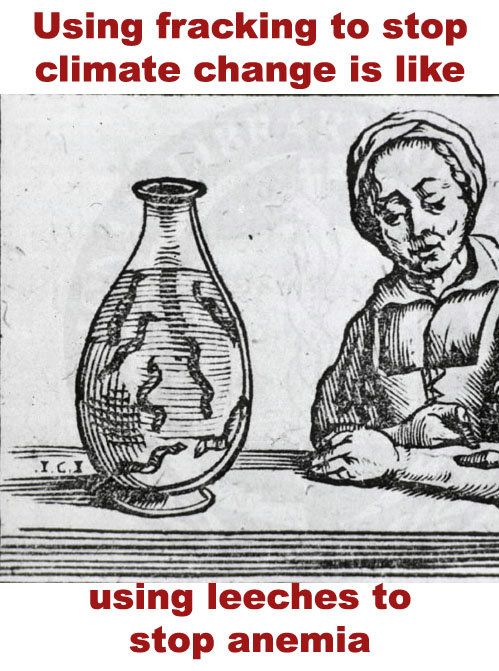
So I have this friend, she’s the literal type, and she saw my post about the leeches and anemia made in response to the State of the Union address. She thought it was clever but admitted she was a little hazy on the connection between global warming and fracking.
After some thought, it dawned on me: why would she get it? For a long time in Texas we’ve been pussy footing around the fact that fracking releases methane and methane from oil and gas operations are a MAJOR contributor to global warming. Not that it isn’t happening. It’s just such a damn hard sell here we get a little tired of pushing a rope. Global warming denying is an artform in Texas. Believe it or not, it’s easier to convince a Texan that the gas companies are poisoning their children by releasing neurotoxins and carcinogens into the air than it is to convince them that man may have a role in the warming planet. The tragedy is BOTH are true.
IN ADDITION to releasing toxins into the air we breathe, the enormous amount of methane released from gas drilling processes when they work correctly, and, worse yet, when they fail, is having a tremendous impact on global warming. So here are the details, courtesy of Tony Ingraffea and partially paraphrased by me, that I gave my friend so she could get her literal mind around the leeches:
EPA-reported emissions are calculated and reported as what are called CO2eq,
CO2 is a greenhouse gas (GHG)
CO2 + other GHGs like methane (CH4) = CO2eq (CO2 equivalents)
The problem is that not all gases have the same effect on global warming. So, by convention, other greenhouse gases are rated according to their effect on warming relative to that of CO2. That rating is called the Global Warming Potential (GWP) which is the ratio of the heating potential of another gas relative to that of CO2. With me so far?
I’m with you, Tony, but just barely. CO2 is number 1 and the hotness factor, or GWP, of other GHG are relative to that.
Now, the Code of Federal Regulations (CFR), the law of the land that EPA and other government agencies must follow, has ENCODED a GWP of 21 for methane. That number is based on science completed before about 1997, maybe earlier, and GWP’s are constantly evolving as more is understood about atmospheric chemistry and global warming. That number 21 [should be] 25 according to the IPCC (Intergovernmental Panel on Climate Change) report of 2007, and is now 33 according to the very latest peer-reviewed science. In other words, Federal law has not kept up with rapidly changing science by at least 15 years.
This is why people keep referring to the hotness factor of methane as 21 or 33. It’s been repeated for the past 15 or so years and it’s stuck. Sort of like the way some people still say ice box when they mean refrigerator.
It gets worse. Those numbers, 21, 25, 33, also result from a policy assumption, not just science. Here is why.
The GWP for methane depends very strongly on WHAT PERIOD OF YEARS ONE WANTS TO MAKE THE COMPARISON WITH CO2. That is a policy judgment call. The numbers 21, 25, and 33 are for a 100-year time horizon, in other words, taken over a 100 year period, how much more heating will methane cause relative to CO2 over 100 years?
IMHO, who the hell cares about 100 years if we are, as Obama is saying, very worried about acceleration of global warming over the next few decades? The latest climate science estimates predict we will most likely be at 2 degrees C global warming in about 40-50 years, and really bad things will happen well before 50 years. So, we should be looking at a shorter time horizon for GWP, right? Well, over a 20 year time horizon, the latest science says that the GWP for methane is as much as 105, not 21, not 25, not 33. Yikes!
NOTE: According to the Intergovernmental Panel on Climate Change, methane is 86 times as potent as carbon dioxide over a 20-year time scale. (Chapter 8, Table 8.7 on page 8-58).
So…Like people, young methane is super hot, old methane is still hot but not so much. Until methane turns 20, it really gets around (disburses) so it’s 105 X hotter than CO2. But as methane ages it’s hotness factor goes down. At 100 yo, it’s hotness factor compared to CO2 is about 21 or 33.
So, what does this mean wrt the EPA emissions announcement this week? That 225 million metric tons of emissions from oil and gas is a low ball estimate (it is NOT an actual measurement) consisting partly of CO2 and partly of methane, and they are converting the methane emissions to CO2-equivalent emissions using the number 21: old science, short-sighted policy judgment.
The same reasoning applies to the issue of whether the U.S. has REALLY made progress on its own against global warming. You recently read that CO2 emissions have decreased over the last few years in the U.S. True, and significantly because total energy use in the U.S. has decreased, and renewables that do not emit CO2 have increased. But, CO2eq has increased from the U.S. over those years because the U.S. is emitting more methane during those years.
She said, “Oh, shit.” Then she passed out. I told the doctors to apply leeches. (Ok, I made that last part up).
About Sharon Wilson
Sharon Wilson is considered a leading citizen expert on the impacts of shale oil and gas extraction. She is the go-to person whether it’s top EPA officials from D.C., national and international news networks, or residents facing the shock of eminent domain and the devastating environmental effects of natural gas development in their backyards.
- Web |
- More Posts(5121)


heh I agree with that picture. Which I also found very amusing by the way.
TCEQ doesn’t even test for methane on their suma canisters or their air monitoring stations. Louisiana tests for methane…they don’t want to see their minerals go to waste….we just want to baby our drillers and make them fix their leak$.
and NOT make them fix their leaks$$$
http://trib.com/news/state-and-regional/jackson-co-op-cited-for-gas-pipeline-emissions/article_f16884fb-ebfb-5ce8-8e40-ed082a4e671c.html
JACKSON, WY — State regulators say the pipeline that provides natural gas to Jackson is emitting too much gas into the atmosphere in Sublette County.
The Wyoming Department of Environmental Quality issued a violation notice to Lower Valley Energy because of the emissions last month. The department and the electrical cooperative, which serves parts of western Wyoming and eastern Idaho, are currently in negotiations over a penalty.
The problem was found at a gas compression station in Sublette County, which sometimes has ozone-based air pollution that rivals that found in Los Angeles. DEQ says the co-op is routing vapors through a boiler instead of an emission control device.
The boiler hasn’t been fixed yet. Lower Valley wants to wait for warmer weather to do the construction work.
More of that harmless leftover salt water explodes:
http://www.huffingtonpost.com/2013/02/15/west-virginia-eqt-explosion-natural-gas-taylor_n_2695700.html
MORGANTOWN, W.Va. (AP) — State regulators say a worker was killed Friday morning in an explosion at an EQT natural gas well pad near Flemington in rural Taylor County.
Department of Environmental Protection spokeswoman Kathy Cosco said the unidentified victim was working alone at the time.
The man was attempting to transfer briny wastewater from a tank into a truck, she said. What sparked the explosion is unclear and will be the focus of the state’s investigation, already under way.
Drillers inject massive volumes of water, sand and chemicals to hydraulically fracture, or frack, the rock in which gas deposits are trapped. The gas then flows up for collection, as does the brine. The DEP says some of the chemicals in the brine could be flammable.